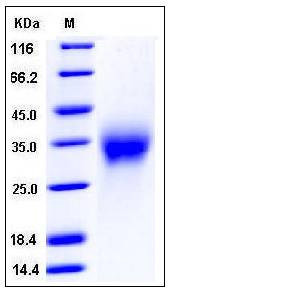Mouse ACVR2A / ActrIIa Protein (His Tag)
ActrIIa,Acvr2,TactrII
- 100ug (NPP1039) Please inquiry
| Catalog Number | P50613-M08H |
|---|---|
| Organism Species | Mouse |
| Host | Human Cells |
| Synonyms | ActrIIa,Acvr2,TactrII |
| Molecular Weight | The secreted recombinant mouse ACVR2A comprises 126 amino acids and has a calculated molecular mass of 14.8 kDa. As a result of glycosylation, the recombinant protein migrates as an approximately 35 kDa band in SDS-PAGE under reducing conditions. |
| predicted N | Ala 20 |
| SDS-PAGE |  |
| Purity | > 97 % as determined by SDS-PAGE |
| Protein Construction | A DNA sequence encoding the extracellular domain of mouse ACVR2A (NP_031422.3) (Met 1-Pro 134) was expressed, with a C-terminal polyhistidine tag. |
| Bio-activity | Measured by its ability to neutralize Activin-mediated inhibition on MPC11 cell proliferation. The ED50 for this effect is typically 0.6-3 μg/mL in the presence of 10 ng/ml Recombinant Human Activin A. |
| Research Area | Cancer |Invasion microenvironment |Angiogenesis |Growth Factor & Receptor |Transforming Growth Factor Beta (TGF-beta) Superfamily |TGF-beta Superfamily Receptors | |
| Formulation | Lyophilized from sterile PBS, pH 7.4 1. Normally 5 % - 8 % trehalose, mannitol and 0.01% Tween80 are added as protectants before lyophilization. Specific concentrations are included in the hardcopy of COA. |
| Background | ACVR2A and ACVR2B are two activin type II receptors. ACVR2A has been shown to interact with INHBA, SYNJ2BP and ACVR1B. The bovine ACVR2A gene encodes a protein of 513 amino acids which is highly homologous (approximately 98% identity) to the rat, mouse, and human ACVR2A proteins. Inactivation of ACVR2A is a common event in prostate cancer cells suggesting it may play an important role in the development of prostate cancer. The ACVR2A gene is a putative tumor suppressor gene that is frequently mutated in microsatellite-unstable colon cancers (MSI-H colon cancers). Frameshift mutation of ACVR2A may contribute to MSI-H colon tumorigenesis via disruption of alternate TGF-beta effector pathways. |
| Reference |
